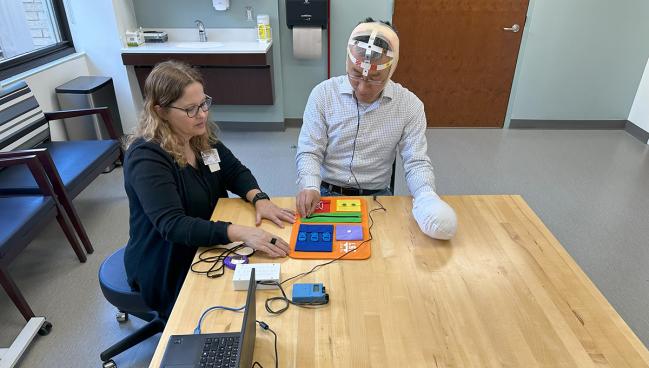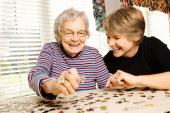Electrical Brain Stimulation Fails to Improve Poststroke Recovery
The findings are disappointing, but questions around intervention timing, patient population, and others remain to be explored.

Wayne Feng demonstrates transcranial brain stimulation with constraint-induced movement therapy. Photo Credit: Ziping Huang
Administering transcranial direct current stimulation (tDCS) along with rehabilitation therapy failed to significantly enhance motor recovery after ischemic stroke in the phase II TRANSPORT2 trial.
Upper-extremity function improved to a similar extent regardless of whether patients had sham stimulation or received one of two different strengths of tDCS, with sustained improvements across all three groups through up to 3 months of follow-up, Gottfried Schlaug, MD, PhD (UMass Chan Medical School – Baystate, Springfield, MA), and Wayne Feng, MD (Duke University School of Medicine, Durham, NC), reported last week at the International Stroke Conference (ISC) in Los Angeles, CA.
The intervention was shown to be safe, tolerable to patients, and feasible to implement, Feng said, adding that future research may focus on using stronger stimulation, standardization and adjudication of outcomes, and greater efforts to speed trial recruitment.
The findings of the phase II study, the first trial of brain stimulation for stroke recovery funded by and fully conducted through the NIH StrokeNet, are set to be published in Lancet Neurology.
Commenting for TCTMD, Ameer Hassan, DO (Valley Baptist Medical Center and University of Texas Rio Grande Valley, Harlingen, TX), said he was disappointed, but not necessarily surprised, by the results. “It has been very hard to find the appropriate neuroprotectant or direct stimulation in order to improve patient outcomes,” he added.
The approach studied here is appealing, he indicated, because it’s noninvasive, it can be implemented easily, patients adhered to it well, and there were no safety concerns.
The next step should be to study the delivery of tDCS at different intervals after a stroke to see whether the timing matters, use for longer than 2 weeks, and perhaps intervening in younger patients with greater neuroplasticity, said Hassan, a member of the American Heart Association’s Stroke Systems of Care Advisory Group.
He underscored the importance of continuing to search for ways to improve poststroke recovery, noting that “we’ve significantly decreased mortality, but we still have the number one cause of disability in the world.”
TRANSPORT2
Transcranial direct current stimulation delivers a weak electrical current to the brain via electrodes placed on the skull. The technology can be used in combination with rehabilitation therapies and is portable, easy to use, and relatively inexpensive, Schlaug said. The stimulation, he added, might modulate the interhemispheric interaction that is disturbed by stroke and can enhance synaptic plasticity and the remodeling of networks.
Several proof-of-concept studies have indicated that tDCS, combined with rehabilitation, “can modulate brain activity and excitability and can induce behavioral changes in stroke patients,” Schlaug said, though larger trials confirming the effects have been lacking.
TRANSPORT2 was designed to further explore the potential impact. The trial included patients who were 1 to 6 months out from a first-ever ischemic stroke and had unilateral limb weakness considered mild to moderate (Fugl-Meyer upper extremity score ≤ 54 out of 66).
All patients received modified constraint induced movement therapy (mCIMT) for rehabilitation. They were randomized to three groups: sham stimulation (n = 41), tDCS at 2 mA (n = 43), and tDCS at 4 mA (n = 43). The intervention consisted of 10 sessions over a 2-week period; each session involved 2 hours of mCIMT combined with 30 minutes of tDCS.
The primary outcome was the change in Fugl-Meyer upper-extremity score from baseline to day 15, with improvements seen in all three groups—adjusted mean change was 4.91 points in the sham group, 3.87 points with lower-dose stimulation, and 5.53 points with higher-dose stimulation (P = 0.39). The lack of difference between the arms was consistent across subgroups.
Other outcomes, including the Wolf Motor Function Test and the Stroke Impact Scale, also revealed no significant impact of tDCS.
A secondary objective of the trial, Feng said, was to determine the safety, tolerability, and feasibility of delivering tDCS. There were no clinically important adverse events, which included severe headache, second-degree skin burn, clinical seizure, and neurological deterioration, and no deaths. Though there were five serious adverse events in the 4-mA arm, and two in the sham arm, they were not considered possibly/definitely related to the intervention.
In terms of tolerability, patients provided low ratings of discomfort across groups. All but three patients (in the sham group) completed at least eight of the 10 treatment sessions, supporting feasibility.
More Work Ahead
Speaking with TCTMD, Lauren Sansing, MD (Yale School of Medicine, New Haven, CT), chair of ISC 2025, indicated that this isn’t the end of the line for tDCS.
“We’re still learning about this technology,” she said. “We don’t really completely understand where are those windows of potential plasticity.”
In addition to exploring the timing and length of the intervention, Sansing said there is also a need to answer questions related to potential sex differences in response and which rehabilitation therapies might be best paired with it, for instance.
“This was an incredible opportunity to learn where we understand things and where we don’t understand things,” she said. “It’s a negative trial, of course, and so that’s disappointing, but I think it offers an incredible database to search now and look for where potential signals may be.”
Bijoy Menon, MBBS, MD (University of Calgary, Canada), vice chair of the meeting, said the size of the study, primarily designed to test safety and feasibility, likely contributed to the neutral results and, like Hassan and Sansing, he also indicated that more research is warranted. It’s possible, for example, that a higher dose of tDCS might be needed or different outcomes are needed, he suggested.
“Although the trial result itself was neutral, I think safety is very promising, and it does open up the potential to actually do larger studies, possibly in an adaptive manner to actually comprehensively understand those things,” Menon said.
Todd Neale is the Associate News Editor for TCTMD and a Senior Medical Journalist. He got his start in journalism at …
Read Full BioSources
Feng W. Transcranial direct current stimulation for post-stroke motor recovery – a phase II study (TRANSPORT2). Presented at: ISC 2025. February 6, 2025. Los Angeles, CA.
Disclosures
- Feng reports receiving grants from the National Institutes of Health (NIH) and the American Heart Association (AHA)/American Stroke Association; being a consultant for NAMSA; and being on scientific advisory boards for the AHA, the California Institute for Regenerative Medicine, and the Burke Rehabilitation Institute.
- Schlaug reports receiving grants from the NIH and the National Science Foundation and a translational seed award from the UMass Initiative on Neurosciences.





Comments